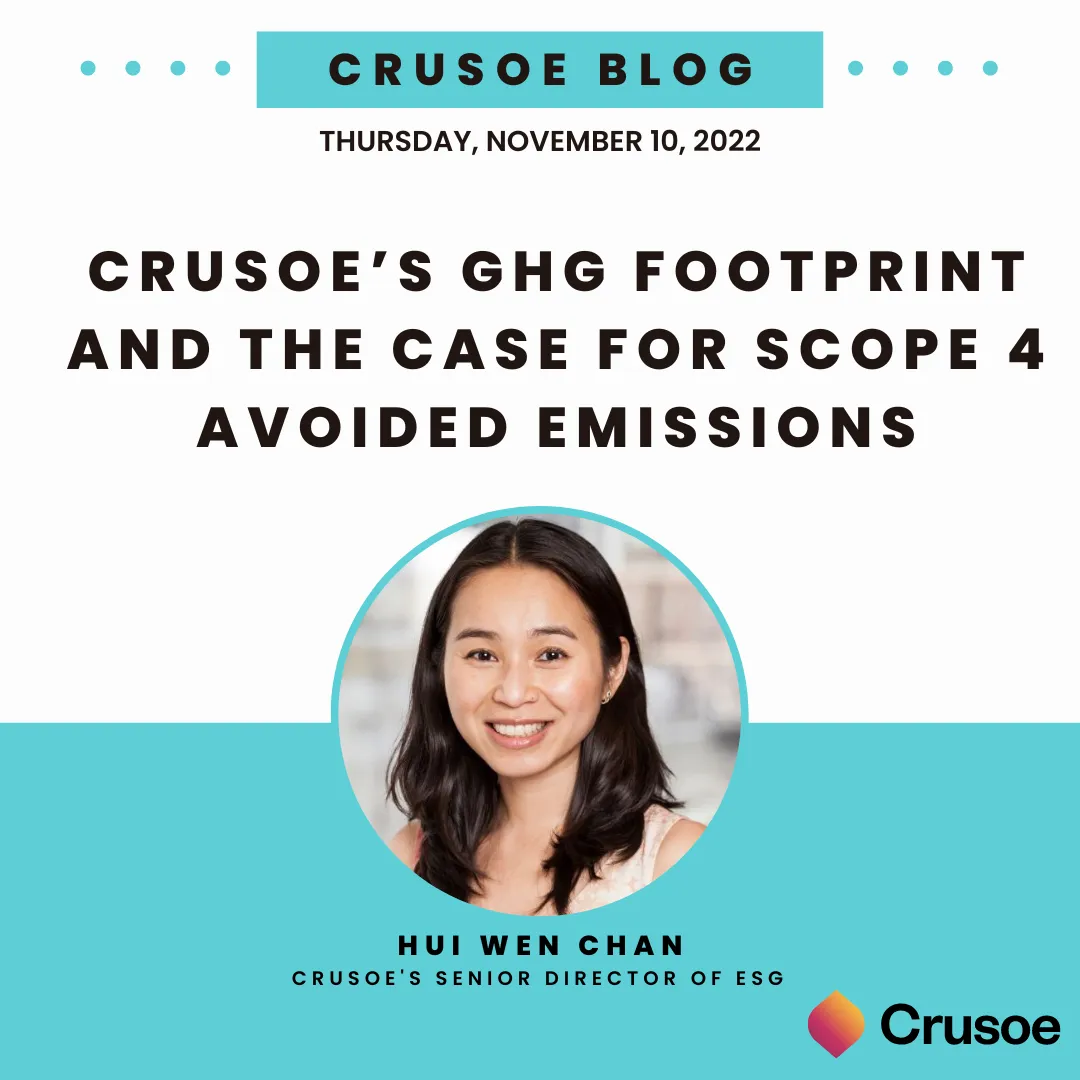Crusoe’s GHG footprint and the case for Scope 4 avoided emissions
In November's blog post, Crusoe’s Senior Director of ESG Hui Wen Chan gives an overview of our greenhouse gas emissions footprint and the impact we are having on the atmosphere when deploying our Digital Flare Mitigation® solutions. Hui also provides a deep dive into Scope 4 emissions and discusses why it is critical to consider the innovative work companies like Crusoe are doing to reduce emissions.

Crusoe’s GHG Footprint and the Case for Scope 4 Avoided Emissions
As a climate tech company focused on addressing climate change by reducing energy waste – in particular, the flaring of natural gas that leads to significant avoidable methane emissions – it was important to Crusoe to understand our greenhouse gas (GHG) emissions footprint and the impact that we are having on the atmosphere when deploying Digital Flare Mitigation® (DFM) solutions.
To assess our GHG footprint, we recently completed a full accounting of our 2021 emissions using the GHG Protocol’s Corporate Accounting and Reporting Standard. We partnered with Emitwise, a third party carbon accounting platform that allowed us to robustly measure, track, and manage our emissions in accordance with the GHG Protocol.
Ultimately, the goal of emissions accounting is to understand the real impacts that companies have on the planet – and that should include not just what companies are contributing to global emissions, but also what companies are reducing or avoiding through the use of their products and services. That is why, in addition to measuring our emissions in accordance with the GHG Protocol, we also calculated our “avoided emissions,” sometimes referred to as Scope 4. Though Scope 4 is currently not yet an official part of the GHG Protocol, the concept is gaining momentum and credence within carbon accounting circles. Scope 4 accounting helps address a gap in the GHG Protocol by painting a more complete picture of companies’ positive and negative GHG impacts, and Crusoe is one of a growing number of stakeholders advocating for the incorporation of Scope 4 into the GHG Protocol.
The Greenhouse Gas (GHG) Protocol
The GHG Protocol establishes the gold standard for measuring and managing greenhouse gas emissions. It creates a global standardized framework that is the most widely adopted by companies and governments around the world.
Under the GHG Protocol, emissions are divided into 3 different “scopes”:
- Scope 1 is direct emissions. These are the emissions from combusting fuel in facilities, vehicles, and equipment that a company owns or leases.
- Scope 2 is indirect emissions from purchased electricity, heat and steam.
- Scope 3 is indirect emissions from everything else in a company’s value chain. These emissions are divided into 15 categories, some of which represent upstream emissions and some downstream.
Crusoe’s carbon accounting included all scopes and all relevant Scope 3 categories, which are primarily upstream, like purchased goods and services, capital goods, business travel, upstream transportation, waste from operations, and employee commuting and remote work.
Crusoe’s GHG Footprint
Here is Crusoe’s GHG footprint for 2021:
Given Crusoe’s business model – we capture natural gas that would otherwise be wasted through flaring and convert it into electricity to power modular data centers – it’s not surprising that our Scope 1 emissions are our highest scope category. These Scope 1 emissions – primarily from the combustion of natural gas in our DFM systems – and related fuel and energy-related activities (FERA) – a category under Scope 3 that covers upstream emissions from purchased fuel and electricity, and transmission and distribution losses – accounted for approximately 86% of our total emissions.
Crusoe generates the majority of the electricity that we use – over 220,000 MWhs in 2021 – so the amount of electricity that we purchase is very small. To signal our support for the energy transition towards renewable and clean energy sources, we purchased Green-e certified renewable energy certificates (RECs) for 100% of the electricity that we purchased from the grid and used in our offices, warehouses and operations. In the diagram above, we showed our Scope 2 market-based emissions prior to the purchase of RECs; with RECs, our market-based emissions are zero.
After FERA, the next biggest categories of our Scope 3 emissions are capital goods and upstream transportation, accounting for emissions from the manufacturing, transportation, and delivery of our equipment.
But Crusoe’s GHG footprint, measured using the GHG Protocol, does not tell the full story of our impacts on climate.
Our Scopes 1, 2 and 3 emissions measure the amount of emissions we generated in the course of our operations. However, that only partially reflects our company’s impact on the climate. Crusoe’s business activities help to reduce flaring of natural gas, a common practice in oil production, and associated methane emissions. In 2021, Crusoe reduced flaring by nearly 1.7 billion cubic feet of natural gas. (For more information, see Crusoe’s previous blog post on minimizing the harm of methane emissions through flare reduction.)
There is currently no standardized approach to measuring Scope 4 avoided emissions, nor one universal definition of what it is. We used one common definition to guide us – “GHG emissions impact of a product relative to the situation where the product does not exist” (Finkbeiner and Bach 2021). In our case, this meant comparing the emissions from using our DFM systems to the emissions that would have resulted from the flaring of natural gas in its absence.
We then used formulas from the U.S. Environmental Protection Agency to calculate the emissions from our generators – which have a regularly measured and confirmed combustion efficiency of 99.91% – and the emissions that would have been generated by open flares – which the latest research from the University of Michigan found were on average only 91.1% efficient. In other words, about 9% of the methane directed to a flare escapes to the atmosphere compared to less than 0.1% with Digital Flare Mitigation.
Based on this comparison, we estimate that had the natural gas we consumed been flared in our absence, it would have resulted in nearly 2,700 metric tons of methane escaping into the atmosphere. Methane is a GHG that traps very large quantities of heat in the first several decades after it is released into the atmosphere. As a result, methane has the most significant impact on global warming in the near term, which is why we use the 20-year global warming potential (GWP) for methane – 82.5 times that of carbon – in our calculations. This 20-year GWP also aligns closely with the international goal of limiting global warming to 1.5oC set in the Paris Climate Agreement, which would require drastically reducing emissions in the near term – halving it by 2030 and reaching net zero by 2050. Using this conversion, Crusoe’s 2021 methane emissions reductions translated to over 220,000 metric tons of CO2e emissions avoided.
Not only does Crusoe reduce the Scope 1 emissions of oil operators (because we reduce the amount of gas they are flaring), our Scope 1 emissions reflect a net overall reduction in Scope 1 emissions for the same volume of natural gas. That is because the emissions associated with the gas that would have been flared in our absence would be nearly 70% higher than Crusoe’s Scope 1 emissions due to the lower combustion efficiency of open flares and the leakage of highly potent methane into the atmosphere.
In total, by preventing flaring, we reduce more emissions than we generate across all of our business activities, providing a net reduction in greenhouse gas emissions of approximately 81,000 metric tons of CO2-equivalents (mtCO2e). This means the amount of emissions we eliminate is about 160% of the emissions we generate (Scopes 1, 2 and 3 combined). This net reduction is equivalent to the GHG avoided by switching over 3,000,000 light bulbs from incandescent lamps to LEDs.
And this does not account for the additional emissions that would have been generated had the same computing assets been powered by connecting them to the grid rather than using flared gas – an additional 85,000 mtCO2e based on the U.S. grid average. Combining our methane abatement and grid emissions avoidance results in nearly 300,000 fewer metric tons of CO2e, compared to a baseline scenario with flaring and the use of grid power. This is the equivalent to the emissions avoided by running about 81 modern large-scale wind turbines for a whole year.
The energy transition to carbon-free energy sources is an environmental imperative, but it is a process that will require decades, if not generations, and many trillions of dollars of capital investment. As the world works through this transition, Crusoe is reducing the negative environmental impacts of oil production by mitigating natural gas flaring and energy waste. This means that as we continue to grow and deploy more DFM systems to address flaring and methane emissions, our emissions will grow, especially our Scope 1 emissions. But our Scope 4 emissions reductions will grow even more – and that’s a net positive for the environment.
Through Crusoe’s expansion throughout the United States and internationally, we will reduce even greater levels of natural gas flaring and achieve higher net reductions in GHG emissions. In addition to the environmental benefits discussed above, that captured energy will be used to run data centers that are powering computing and innovation, creating a positive benefit to society rather than just letting it go to waste.
The Case for Developing a Scope 4 Framework
The GHG Protocol is important for creating a global standardized framework for carbon emissions accounting and reporting. But the GHG Protocol Corporate Standard, first published in 2001, was last updated in 2015. A lot has changed since then. There are a growing number of innovative, cleantech companies like Crusoe whose purpose is to help reduce, or even remove, emissions. Those emissions avoidance and removal efforts will help us get closer to achieving the Paris Climate Agreement since most pathways to reaching net zero emissions by 2050 require large volumes of carbon abatement and removal. But without a universally-accepted Scope 4 standard that provides a consistent framework for how companies measure and report avoided emissions or emissions reduction, companies can’t use the GHG Protocol to tell the full story of their emissions impact. As the World Resources Institute (WRI) and World Business Council for Sustainable Development (WBCSD) look to update the Protocol, we encourage them to add a framework for Scope 4.
In addition, as more and more investors and stakeholders ask companies to do carbon accounting using the GHG Protocol to understand their environmental footprint and impact, we want a framework for measuring emissions that incentivizes and rewards companies that develop cleaner technologies, products and services.
We will be publishing a comprehensive ESG report early next year that will continue to incorporate Scope 4 concepts as a part of our commitment to transparency in our carbon footprint and impact. We’ll also continue to add to the thought leadership and advocacy for this important carbon accounting idea – so we can encourage the development of a common, shared framework that helps companies measure not just the emissions they create, but also the emissions they reduce – to give us a more complete picture of how we are all contributing to building a net zero future.



